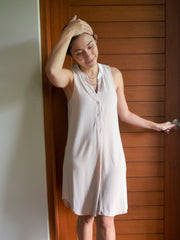Try starting a conversation about “period underwear”, and the first reaction you’re likely to get is, “WHAT?”
Yes, you’ll even hear that from educated women, sustainability enthusiasts, and advocates of mindful lifestyles. While it’s true that we have already come a long way from the “hush-hush” attitude and taboos around menstruation in general over the last couple of decades, the truth is, there is still a long way to go.
It is the year 2024, and while other countries like Australia have period underwear readily available in grocery aisles together with other menstrual products, so many Filipinos still don’t know enough about this option, and why it could possibly be the best option for them to use on their period journey.
Here is why Period Underwear must be part of your menstrual health knowledge, awareness, and journey (if you’re someone who experiences menstruation, or someone close to you does):
Caring for the Environment

This comes as absolutely no surprise, but the majority of women in the Philippines still name single-use pads or napkins as their period product of choice. And this is just the opinion among women. There are no available statistics about trans people and gender non-conforming individuals who menstruate.
But we know that commercially available single-use products like napkins, pads, and tampons, are made from around 90% plastic components. Each time a single-use product is consumed and disposed of, it ends up in landfills or oceans that contribute to the global plastic pollution crisis, of which the Philippines is famously a huge contributor.
“Menstruating people use an average of 10,000 sanitary products in their lifetime, so the use of conventional sanitary pads that are made of plastic and use single-use plastic packaging generates a significant amount of plastic wastes” (Valentin & Hechanova, 2023).
While the pollution and climate crises are too great to be solved by any single initiative, experts agree that the more people who develop eco-friendly and sustainable practices, the more opportunity there is to stem the negative effects of human consumption on the planet. Switching from single-use to reusables is a significant way to do this. For menstruators, this means going for menstrual cups, discs, period underwear, or cloth pads (referred locally to as pasador).
But if reusable period products like these are not available online, in stores, schools, or workplaces, how will menstruators learn about them and start using them? These need to be made visible and accessible.
Personal Health & Wellness

Menstruation is a highly personal experience. Scientifically, every person who has their period will experience it uniquely, through there are common elements such as: fluctuations in energy and mood, the potential to experience period pain, and of course, the need for period products to manage your blood flow (though there are people who also prefer to free-bleed).
And more than the physical aspects of menstruation, we cannot overlook that this experience has a psychological and emotional dimension.
- For trans men and gender non-conforming people, the experience of menstruation can be distressing and contribute significantly to body dysmorphia and mental wellness challenges.
- For menstruators who experience menstrual and sexual health-related illnesses like Polycystic Ovarian Syndrome (PCOS) or Endometriosis, their quality of life can deteriorate as they manage these illnesses for many years.
- For people who are neurodivergents, or have physical or health-related differences, periods can become harrowing experiences, especially if in a world where no one talks about menstrual education and support, much less their specific needs.
Everyone, regardless of who they are, how they live, and their ability to pay for things, must have access to period products that will enable them to stay healthy in body and mind. Different products have different pros and cons for every user.
While period cups and discs are a great reusable product, there may be those who are sensitive or challenged by inserting products into their bodies. For gender non-conforming individuals, they may benefit from period product options that are packaged and designed to suit their identity, and not just a commercial target market. And for people who are going through illnesses or different abilities, they may have specific needs that typical products cannot address.
More than products being accessible, they must also be designed to cater to the diverse needs of menstruators.
Why use Period Underwear?

Period underwear has truly flown under the radar as far as sustainable period options go, considering how “basic” they are in form and function.
Period underwear and cloth pads are the closest sustainable option to single-use pads. As long as you have used a pad before, you already know how to use period undies (whether panties, boxers, briefs, or what you prefer). It is basically a cloth pad or pasador, but built into your underwear – so it doesn’t cause discomfort by moving or shifting while you wear it.
When it has done its job of absorbing blood to capacity, then it is time to change to another, though they can also be used for hours without changing depending on your flow. Though not immediately, period underwear does have to be washed after use.
Behaviorally, this is the biggest challenge when you switch to period underwear – managing the washing. This may require a little more planning on the part of a menstruator who spends most of the day outside home. However, the tradeoff is thousands of single-use products that are convenient, but end up choking the planet. (Remember, every single pad or tampon you have used in your whole life is still existing in a landfill somewhere!)
But possibly the best thing about period underwear is that they are in fact, pieces of clothing! They are meant to be kept and used for as long as possible. They can be used in different ways – not just for periods!
- They are for any type of profuse sweating, wetness, or other leaks you may experience (such as for postpartum moms, people experiencing incontinence, or those who just discharge often).
- They can also come in different designs that suit your physical and mental needs – from correct sizing, to aesthetic preferences, and of course, gender affirmation.
For this reason, many have made the transition intentionally and successfully.
Overall, period underwear is hugely underrated. It may not be the period product option for everyone, but it may be the best option for some.







